|
England

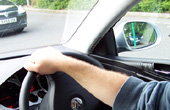 Upon arriving at Gatwick Airport, our first order of business was securing a rental car. Adjusting to driving on the wrong side of the road was no easy task, but luckily that duty fell to Rick. Our first stop was Canterbury, a two hour drive away from the airport that offered plenty of time for practice. Yet that first day we managed to clip a parked car with the side mirror. But once the other driver realized we were clumsy Americans, he cheerfully helped us along.
Upon arriving at Gatwick Airport, our first order of business was securing a rental car. Adjusting to driving on the wrong side of the road was no easy task, but luckily that duty fell to Rick. Our first stop was Canterbury, a two hour drive away from the airport that offered plenty of time for practice. Yet that first day we managed to clip a parked car with the side mirror. But once the other driver realized we were clumsy Americans, he cheerfully helped us along.
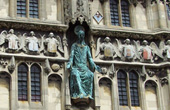
 Canterbury itself sits in the southeast of England and has traditionally been an epicenter of English religious leadership. At the heart of the city is Canterbury Cathedral, an incredibly historic place of worship for over 1,400 years. Christ Church Gate, pictured left, forms an imposing entrance to the Cathedral Precincts. Christ is featured in the center amidst carvings dedicated to Henry VIII's brother Prince Arthur. A grunge concert in front of the gate, pictured right, provided a stark contrast of modern secularism.
Canterbury itself sits in the southeast of England and has traditionally been an epicenter of English religious leadership. At the heart of the city is Canterbury Cathedral, an incredibly historic place of worship for over 1,400 years. Christ Church Gate, pictured left, forms an imposing entrance to the Cathedral Precincts. Christ is featured in the center amidst carvings dedicated to Henry VIII's brother Prince Arthur. A grunge concert in front of the gate, pictured right, provided a stark contrast of modern secularism.
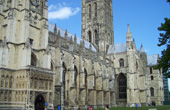



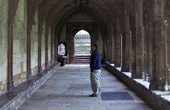

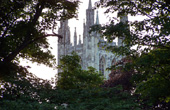
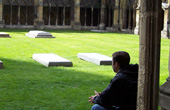
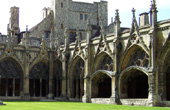 Once inside the precinct grounds, the grandeur of the cathedral is apparent. Like most Cathedrals, it's built in the shape of a cross. And as one of the oldest buildings in England, it has a history to match its design. The Cathedral's first Archbishop was St. Augustine, and later both the Saxons and Normans expanded upon the structure. In 1170 knights overheard King Henry II say, refering to Thomas Becket, "Who will rid me of this meddlesome priest?" The knights took it literally and murdered Becket inside the Cathedral. Later pilgrimages began to a shrine in his honor, inspiring Geoffrey Chaucer's The Canterbury Tales. Today the Cathedral is home to the Anglican Archbishop of Canterbury, the Primate of All England, and the leader of the Church of England.
Once inside the precinct grounds, the grandeur of the cathedral is apparent. Like most Cathedrals, it's built in the shape of a cross. And as one of the oldest buildings in England, it has a history to match its design. The Cathedral's first Archbishop was St. Augustine, and later both the Saxons and Normans expanded upon the structure. In 1170 knights overheard King Henry II say, refering to Thomas Becket, "Who will rid me of this meddlesome priest?" The knights took it literally and murdered Becket inside the Cathedral. Later pilgrimages began to a shrine in his honor, inspiring Geoffrey Chaucer's The Canterbury Tales. Today the Cathedral is home to the Anglican Archbishop of Canterbury, the Primate of All England, and the leader of the Church of England.
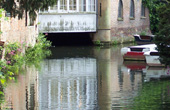
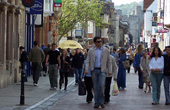 In large part because of the Cathedral, Canterbury has long been a destination for both medieval pilgrims and modern tourists. A less visited site just outside the medieval walls is St. Augustine's Abbey, pictured in the four images below. First used as a monastery by Saxons and, later, St. Augustine, the Abbey declined over time and had virtually disappeared by 1100. Hundreds of years later the ruins were slowly rediscovered. We were fortunate to be able to walk freely among it all at will.
In large part because of the Cathedral, Canterbury has long been a destination for both medieval pilgrims and modern tourists. A less visited site just outside the medieval walls is St. Augustine's Abbey, pictured in the four images below. First used as a monastery by Saxons and, later, St. Augustine, the Abbey declined over time and had virtually disappeared by 1100. Hundreds of years later the ruins were slowly rediscovered. We were fortunate to be able to walk freely among it all at will.
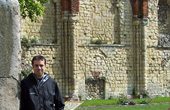

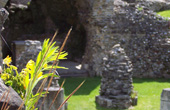

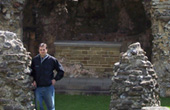

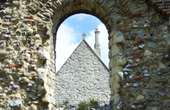
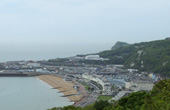
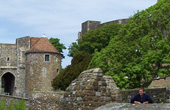 We soon left Canterbury toward Dover, one of the most significant coastal towns in England, in part because of its proximity to France (on a clear day you can see continental Europe). As a result, a castle was built overlooking the port. It has been called "The Key to England" for its defensive significance throughout history, from the Romans through secret tunnels beneath the castle during WWII. I was struck by its extensive earthwork fortifications and continual renovations to suit the wars of the time.
We soon left Canterbury toward Dover, one of the most significant coastal towns in England, in part because of its proximity to France (on a clear day you can see continental Europe). As a result, a castle was built overlooking the port. It has been called "The Key to England" for its defensive significance throughout history, from the Romans through secret tunnels beneath the castle during WWII. I was struck by its extensive earthwork fortifications and continual renovations to suit the wars of the time.


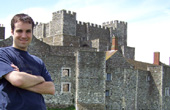

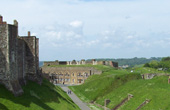

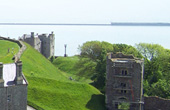
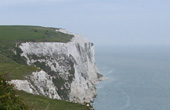
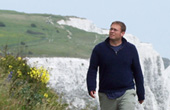 Although the castle is rightfully a focal point of Dover, the area's fabled white cliffs draw plenty of attention. In addition to a natural defensive wall, the cliffs - at left and right - are a symbolic first (or last) sight of Britain for travellers to and from continental Europe. Thereafter we drove along the southern coast toward Hastings, site of the Norman invasion in 1066 that forever shaped the course of human history. But now Hastings is simply a modern coastal town, pictures of which are below.
Although the castle is rightfully a focal point of Dover, the area's fabled white cliffs draw plenty of attention. In addition to a natural defensive wall, the cliffs - at left and right - are a symbolic first (or last) sight of Britain for travellers to and from continental Europe. Thereafter we drove along the southern coast toward Hastings, site of the Norman invasion in 1066 that forever shaped the course of human history. But now Hastings is simply a modern coastal town, pictures of which are below.
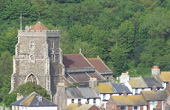

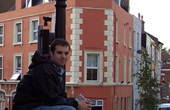

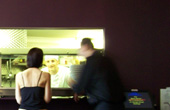


After Hastings we made our way toward London, where Carson joined us, and then traveled west to Stonehenge, pictured first and second below. Following Stonehenge we traveled further west toward Bath, a city made famous by Roman Baths, constructed shortly after their invasion of Britain in 43 AD. Like many ancient sites, the baths were forgotten over time, only to be rediscovered and reopened to the public in 1897.


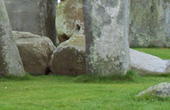



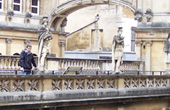

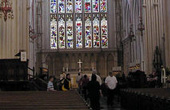 The baths, pictured third and fourth above, are breathtaking in their complexity and advancement. The original lead pipes are still functioning, although this makes it unsafe. The upper portion was built in the 18th century and overlooks the Great Bath. On the same block is the Bath Abbey, an impressive gothic church pictured on the left and right. We also enjoyed Bath because it offered our first opportunity to experience British nightlife. Pictures from our night in Bath are below.
The baths, pictured third and fourth above, are breathtaking in their complexity and advancement. The original lead pipes are still functioning, although this makes it unsafe. The upper portion was built in the 18th century and overlooks the Great Bath. On the same block is the Bath Abbey, an impressive gothic church pictured on the left and right. We also enjoyed Bath because it offered our first opportunity to experience British nightlife. Pictures from our night in Bath are below.




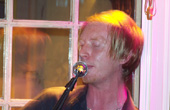

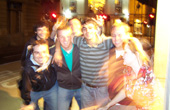
England was quite an experience and we certainly looked forward to returning in London. But our next leg of the journey takes us to Wales. Click here for more on that.
|